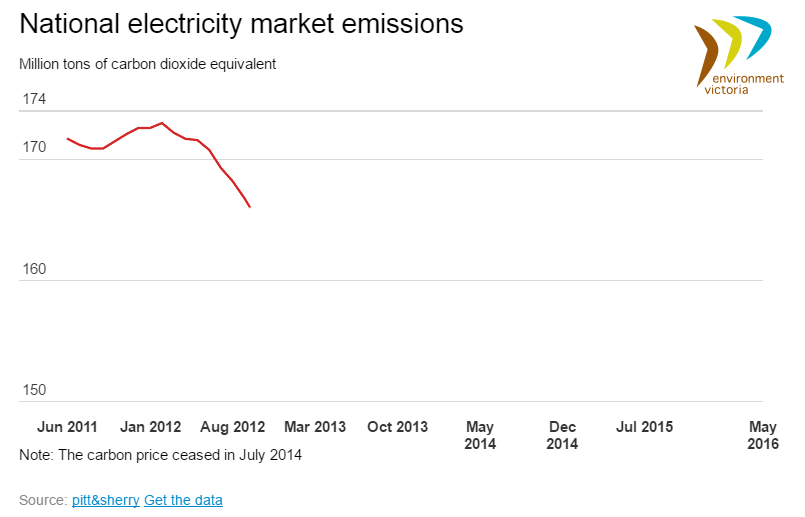 Five reasons why the Coalition’s climate policies are failing
Five reasons why the Coalition’s climate policies are failing
1 Their emission reduction targets are woefully inadequate
Australian emission reduction targets are just 26-28 percent below 2005 levels by 2030. If similar targets were adopted worldwide, it would lead to catastrophic rises in global temperatures of 3 to 4 degrees. Australia’s targets are a lot weaker than those of most comparable countries and even if achieved would still leave us as the highest per capita emitter and most emissions-intensive economy in the developed world.
2 They have no plan to cut climate pollution across the economy
The Emissions Reduction Fund (ERF) is the Coalition’s centrepiece climate change policy, but instead of reducing emissions, it allows them to increase by more than 21 percent above 2005 levels by 2030 [1]. It has failed to reduce emissions across the economy, especially from our biggest polluters in the energy sector: coal-fired power stations. Australia was the first country to remove a price on carbon, which was actually bringing emissions down. Since then, our climate pollution has been rising substantially.
3 They give free rein to the largest polluters – coal-burning power stations
Electricity is mainly generated through dirty coal in Australia, our single largest source of climate pollution. If we want to have a chance to stay below 2 degrees of global warming, we need to phase out all coal power by 2030 at the latest [2]. There is currently no policy mechanism for this to happen in a planned and managed way which treats affected workers and communities poorly and increases the risk of blackouts.
4 They’ve stifled investment in renewable energy
The Coalition has no commitment to support renewable energy beyond the current Renewable Energy Target (RET) of 23 percent by 2020. The policy uncertainty the Coalition has created by cutting the RET and ‘talking down’ renewables is delaying investment and therefore contributing to price increases at a time when the sector is growing in the rest of the world.
5 They’re not prioritising energy efficiency and demand management
Energy efficiency is the number one global action required to stop global emissions rising by 2020 and achieving significant declines by 2030. Australia however is falling behind. Current rates of energy productivity are well below those needed to reach the National Energy Productivity Plan’s 2030 target of 40 percent improvement. The Coalition also terminated the successful Low Income Energy Efficiency Program and Energy Efficiency Opportunities Program.
[1] http://www.climateinstitute.org.au/verve/_resources/ERF-PolicyBrief-WEB.pdf
[2] http://www.climateinstitute.org.au/a-switch-in-time.html
5 ways to fix our climate policies
1 Set targets based on science, not politics
For effective action on climate change in line with our international commitments, we need to base our targets – and climate policies – on scientific evidence rather than politics and ideology. This means that by 2030 our net emissions would have to be around 65 percent below 2005 levels [3]. Australia’s inconsistent, stop-start and inadequate climate policies have wasted much of the past decade. We now need to act at emergency speed to cut climate pollution across the economy.
2 Develop a credible plan for net zero emissions across the whole economy
Australia has no long-term strategy to move to net zero emissions by 2050. To achieve this, we need eonomy-wide measures to reduce pollution, measures to actively remove greenhouse gases from the atmosphere, and for government to stop subsidising polluters and instead make them pay for the damage they cause. At the same time we need to drive policy efforts and funding to adapt to the global warming we have already locked in.
3 Create a national plan to close all coal-burning power stations by 2030
Our largest opportunity to reduce climate pollution is through phasing out Australia’s coal-burning power stations. A ‘Just Transition’ process includes both an orderly transition away from coal and a collaborative and inclusive transition towards a sustainable economy. To do this effectively, we need a national plan for an orderly phase-out of coal-burning power stations that includes a clear and predictable timeline to provide certainty to communities and investors, and ensures Australia’s emissions from electricity fall in line with limiting global warming to 1.5 degrees.
4 Reach 100% renewable energy by 2030
To achieve this, we need ambitious renewable energy targets, firm policies and financial arrangements to drive investment in the sector, dedicated funding and support for community energy projects and reform of the National Energy Market to ensure it is fit to support a modern and sustainable grid.
5 Get serious about building an energy efficient economy
The National Energy Productivity Plan should drive ambitious and coordinated action across all sectors of the economy at a national and state level. An effective approach needs to address market failure and leverage government and private investment.
[3] http://www.climateinstitute.org.au/verve/_resources/ERF-PolicyBrief-WEB.pdf